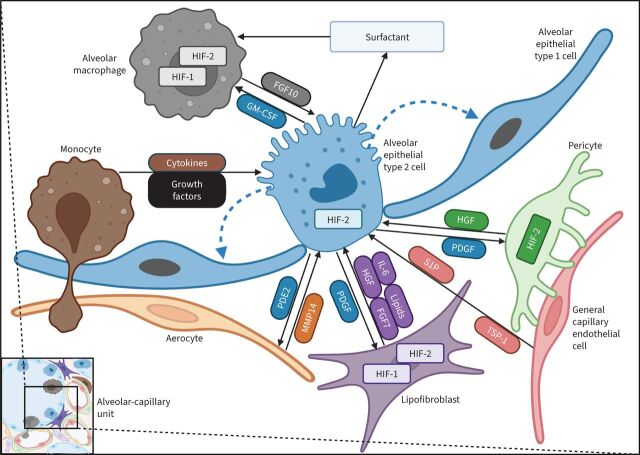FIGURE 2.
Schematic representation of paracrine interactions within the alveolar-capillary unit of the lung: focus on the alveolar epithelium. Alveolar epithelial type 2 (AEC2) cells play a central role in homeostasis as progenitor cells for alveolar epithelial type 1 cells (blue dashed arrows) and producers of surfactant. AEC2 cells are regulated by multiple paracrine interactions between neighbouring cells. The main pro-survival signal is mediated by hepatocyte growth factor (HGF), produced by lipofibroblasts (alveolar fibroblasts) and pericytes in a hypoxia-inducible factor (HIF)-2-dependent manner. Additionally, fibroblasts secrete interleukin-6 (IL-6) and fibroblast growth factor (FGF)-7. In turn, AEC2 cells produce platelet-derived growth factor (PDGF) that regulates fibroblast and pericyte activity. Capillary endothelial cells secrete matrix metalloproteinase-14 (MMP-14), which increases the bioavailability of the cryptic ligands for the epidermal growth factor receptor on AEC2, thus promoting regenerative alveologenesis. On the other hand, AEC2 cells constitutively release prostaglandin E2 (PGE2), promoting endothelial barrier integrity. Alveolar macrophages and bone marrow-derived monocytes can be the source of additional factors affecting AEC2 function and proliferative activity (cytokines, growth factors). In turn, AEC2 cells regulate the pool of alveolar macrophages by granulocyte–monocyte colony stimulating factor (GM-CSF). HIF-2α is the predominant isoform in AEC2 and, probably, pericytes, while fibroblasts express both HIF-1α and HIF-2α. S1P: sphingosine-1-posphate; TSP-1: thrombospondin-1.

